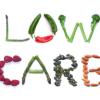CYBERMED LIFE - ORGANIC & NATURAL LIVING
CYBERMED LIFE - ORGANIC & NATURAL LIVING
 Low Carbohydrate: Low-carbohydrate diets or low-carb diets are dietary programs that restrict carbohydrate consumption. Foods high in easily digestible carbohydrates (e.g., sugar, bread, pasta) are limited or replaced with foods containing a higher percentage of fats and moderate protein (e.g., meat, poultry, fish, shellfish, eggs, cheese, nuts, and seeds) and other foods low in carbohydrates (e.g., most salad vegetables such as spinach, kale, chard and collards), although other vegetables and fruits (especially berries) are often allowed. The amount of carbohydrate allowed varies with different low-carbohydrate diets.
Low Carbohydrate: Low-carbohydrate diets or low-carb diets are dietary programs that restrict carbohydrate consumption. Foods high in easily digestible carbohydrates (e.g., sugar, bread, pasta) are limited or replaced with foods containing a higher percentage of fats and moderate protein (e.g., meat, poultry, fish, shellfish, eggs, cheese, nuts, and seeds) and other foods low in carbohydrates (e.g., most salad vegetables such as spinach, kale, chard and collards), although other vegetables and fruits (especially berries) are often allowed. The amount of carbohydrate allowed varies with different low-carbohydrate diets.
Such diets are sometimes 'ketogenic' (i.e., they restrict carbohydrate intake sufficiently to cause ketosis). The induction phase of the Atkins diet is ketogenic.
The term "low-carbohydrate diet" is generally applied to diets that restrict carbohydrates to less than 20% of caloric intake, but can also refer to diets that simply restrict or limit carbohydrates to less than recommended proportions (generally less than 45% of total energy coming from carbohydrates).